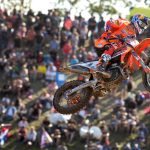It is fair to say that it hasn’t been an easy time for motocross in the past three weeks. First there was the criticism from some corners over the inability of several Grand Prix athletes to deal with forty degree heat for round two of the series in Thailand – one of those classic examples of people finding it incredibly easy to judge from the comfort of their armchair and with their smartphone at their fingertips. Secondly MX2 World Champion Jordi Tixier’s moment of madness while receiving treatment from exhaustion at Nakhonchaisri that led to a month suspension from FIM competition and caused him to miss the Grand Prix of Argentina. Then, mainly for British fans concerned at the direction of their national series, the domestic competition in the UK reached a nadir with the 2015 opening round of eight taking place in an allegedly unsuitable venue with the stench of politics, self-interest and agenda hovering over the Hilton Park circuit. The level of dissatisfaction from some key teams and participants was accentuated by the horrific injury to one of the championship protagonist’s Mel Pocock and subsequent debate over the medical facilities provided.
Pocock’s mangled right hand leaves the former European Champion’s career in the balance while the health and credibility of the British contest will be under scrutiny for at least the rest of 2015 and maybe more in the long-term. I haven’t attended a round of the series for at least half a decade so I am not in a position to cast any judgement on the state of a competition that many have regarded – not least ACU Events – as one of the premium national MX championships in Europe. I was alarmed to read some of the passionate and no-holds-barred interviews on websites like MXvice.com that have done a good job in serving the concerns and views of their principal readership. The strength of words mentioned by people like Forkrent Wilvo team owner Steve Turner makes me believe that perhaps some policies can change for the better (circuits are reviewed, teams better treated and some forward thinking is applied) but there is all-too-familiar feeling that the furore will just ebb back into a status quo as time passes.
As for Thailand…I was standing barely twenty metres away from the waves section where Jeremy Seewer crashed his factory Suzuki and Tixier binned his works Kawasaki with the chequered flag only another thirty metres further up the track. I’ve never seen an incident like it, but watching the Swiss and Frenchman effectively lose control of their bodies and with barely the strength to stand let alone recover their motorcycles was genuinely startling. Seewer even stumbled towards me trackside and I had to tell him to sit down as members of his team, track staff and medical crew ripped off his kit and threw water over a twenty year old that looked as though he might combust. The heat was intoxicating. Literally. Every person deals differently with conditions. It was too much for Seewer, Tixier, Tim Gajser and even race winner Jeffrey Herlings required post-race attention whereas other more experienced hands in MXGP knew that pacing their motos was key.
For idiots to throw criticism and jibes online as the medical centre started to rapidly fill and race officials decided to reduce the second moto by five minutes showed staggering ignorance. For months the vast majority of Grand Prix riders have been training, testing and preparing in a winter climate. Thanks to experience in 2013 and ’14 people knew that Thailand would be humid and draining but this was a new level and the contrast was clearly too great. Individuals have died in American national races in the past and the last tragedy was cited by U.S. Champion and MXGP winner Ryan Villopoto to prioritise safety.
The call to shorten the moto was met with relief by some and indifference by others but the consensus accepted the reasoning. Aside from the 2013 German round at a frying Lausitzring, Nakhonchaisri was the hottest and stuffiest Grand Prix I have attended since 2001 and with some big crashes already seen by riders such as Tommy Searle and Julien Lieber then the FIM cannot be blamed for wanting to moderate the possibilities for more disaster.
I think there is a certain amount of sympathy that can be directed Jordi Tixier’s way. My previous dealings with the young Frenchman have led me to believe that he is a quiet, friendly and almost gentle person, certainly not one to lash out. As with Seewer – who claims he has no memory of what happened to him post-crash – the heat was a mitigating factor but Tixier has also been under pressure thanks to the weight of that ‘1’ on front of the Kawasaki and a damp start to his title defence. There is little doubt that if you ‘do the crime then pay the time’ in this situation and the FIM rightly took a dim view of his behaviour and set the bar in case any other GP athlete cannot resist the urge to talk with their fists. Tixier immediately issued an apology in Thailand and understandably has been in anguish by the turn of events. It is naturally a vast learning experience and if he can retaliate from the purgatory with the same zest that took him to the 2014 MX2 title then it might even be of some benefit. It will be curious to see what Jordi Tixier turns up in Italy.
After the controversy it was refreshing and reassuring to find a new wave of enthusiasm for MXGP in Argentina. The new track at Nakhonchaisri caused more than a few noses to be turned up but the fresh build at Villa La Angostura was highly rated thanks to the peculiar dirt that helped fashion different racing conditions compared to the two precious Grands Prix. As in Brazil it was genuinely enthusing to see such eagerness and anticipation for MXGP. It only gets harder to draw big audiences to premier sport events in the second decade of the century due to finance and a lifestyle where the pace has quickened and time is precious. Argentina has seemingly been waiting for MXGP and the public responded even for quite a hefty entry fee (imposed by the organiser and set almost at European levels). Patagonia involves such a massive hike for the teams and the championship – perhaps the biggest since the Japanese GPs run between 2005 and 2007 – but round three of the 2015 campaign proved that there is a market and a following for the sport.
Photo by Ray Archer








